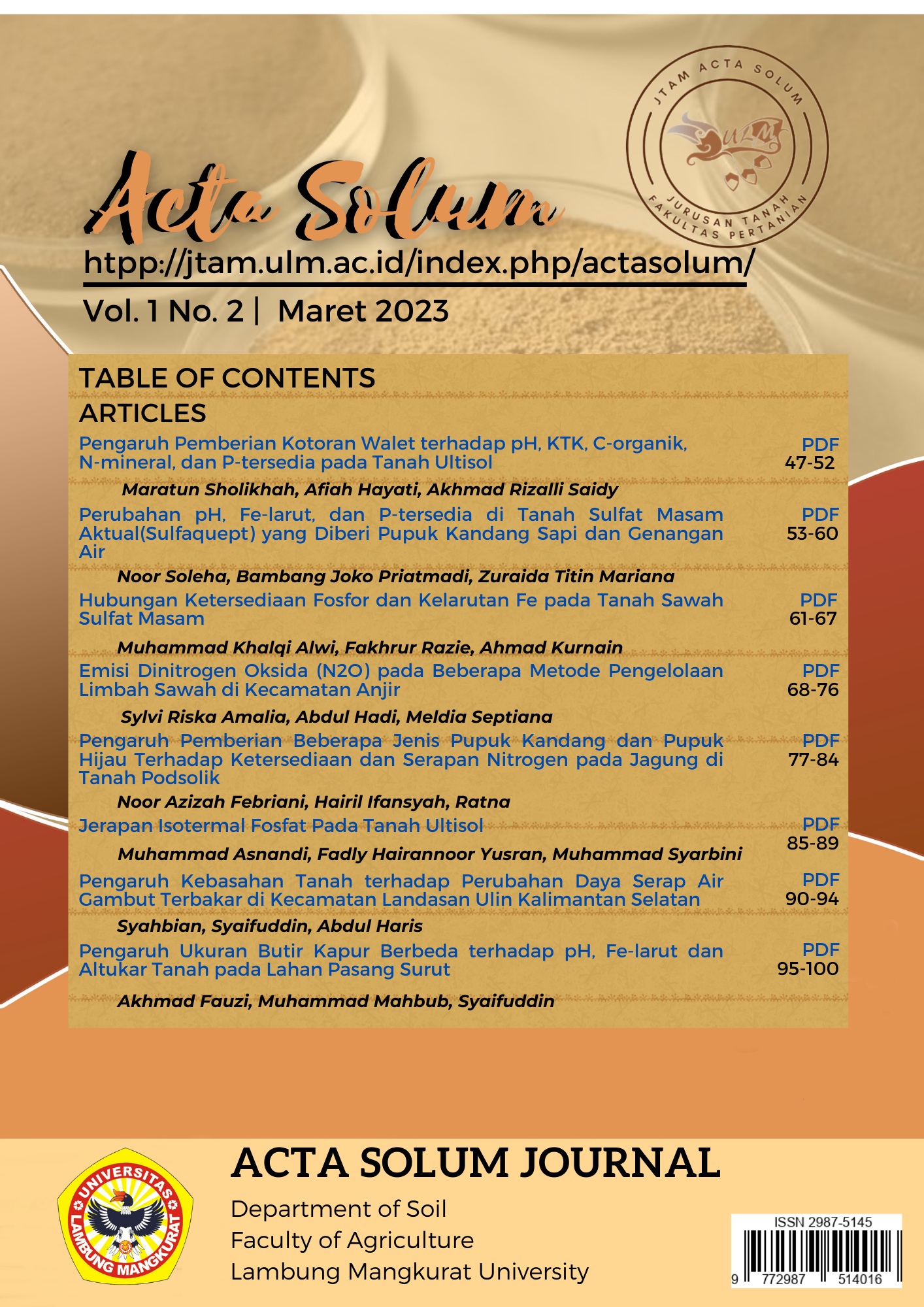Emisi Dinitrogen Oksida (N2O) pada Beberapa Metode Pengelolaan Limbah Sawah di Kecamatan Anjir
Abstract
Wetlands have unique biodiversity and natural phenomena. The climate has recently changed rapidly due to greenhouse gas emissions, especially nitrous oxide from human activities such as paddy rice farming. The purpose of this study is to determine the effect of rice field waste management on the population of nitrogen-fixing bacteria and N2O emissions, and as to determine the shape and closeness of the relationship between the population of nitrogen-fixing bacteria and N2O emissions with different waste management methods. The research method used is a one-factor RGD. Close chamber technique is used for N2O emmisions analysis. The factor tested was the method of managing paddy waste before rice planting with five treatments, namely: A = Rice field waste was slashed and then lifted into the mound after a few days of being returned to the field; B = Rice field waste is carried out management slashed, rolled up, reversed and stretched; C = Rice field waste is slashed, planted with traces and then slashed again after the trace is transferred to land outside the research plot; D = Rice field waste sprayed with herbicide 2 times; E = Rice field waste sprayed with herbicide 1 time and then soil in the tractor. Each treatment was repeated four times so that 20 units of the experiment were obtained. The results showed that the method of rice field waste management carried out had no real effect on N2O emissions and nitrogen-fixing bacteria. N2O emissions not correlate with the activity of nitrogen-fixing bacteria from several methods of rice field waste management carried out
References
Abduh, A.M., Hanudin, E., Purwanto, B.H., Utami, S.N.H. 2020. Effect of plant spacing and organic fertilizer doses on methane emission in organic rice fields. Environment and Natural Resources Journal 18(1), 66-74. doi.org/10.32526/ennrj.18.1.2020.07
Banks, S., White, L., Behnamian, A., Chen, Z., Montpetit, B., Brisco, B., Pasher, J., Duffe, J. 2019. Wetland classification with multi-angle/temporal SAR using random forests. Remote Sens 11(6), 670. doi.org/10.3390/rs11060670
Dakhyar, N, Hairani, A., Indrayati, L. 2012. Prospek pengembangan penataan lahan sistem surjan di lahan rawa pasang surut. Jurnal Agrovigor 5(2), 113118. doi.org/10.21107/agrovigor.v5i2.327
Ekawati, I., Syekhfani. 2005. Dekomposisi tajuk padi oleh biakan campuran bakteri selulolisis dan penambat nitrogen. Jurnal Pembangunan Pedesaan 42(2), 96102.
Hadi, A., Budi, I.S., Salamiah, Wahdah, R., Yusran, F.H. 2021. Aplikasi Teknologi Selaras Watak Lahan Basah. LMU Press. Banjarmasin.
Irawan, M.A.R. 2021. Emisi gas metana dari sawah di kecamatan anjir pasar yang ditanami padi unggul hasil radiasi dan padi lokal. Skripsi Universitas Lambung Mangkurat. Banjarbaru.
Kou-Giesbrecht, S., Menge, D.N.L. 2021. Nitrogen-fixing trees increase soil nitrous oxide emissions: a meta-analysis. Ecology 102(8), e03415. doi.org/10.1002/ecy.3415
Kyuma, K. 2004. Paddy Soil Science. Kyoto University Press. Japan.
Natuhara, Y. 2013. Ecosystem services by paddy fields as substitutes of natural wetlands in Japan. Ecological Engineering 56, 97-106. doi.org/10.1016/j.ecoleng.2012.04.026
Subagyono, Kasdi, Elsa, S. 2007. Pengelolaan sumber daya iklim dan air untuk antisipasi perubahan iklim. Jurnal Meteorologi dan Geofisika 8(1), 27-35. doi.org/10.31172/jmg.v8i1.5

















